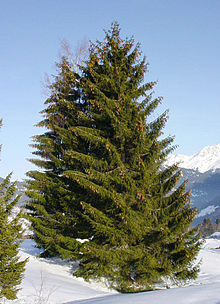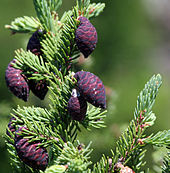- Spruce
-
For other uses, see Spruce (disambiguation).
Spruce 
Norway Spruce (Picea abies) Scientific classification Kingdom: Plantae Division: Pinophyta Class: Pinopsida Order: Pinales Family: Pinaceae Subfamily: Piceoideae
FrankisGenus: Picea
Mill.Species About 35; see text.
A spruce is a tree of the genus Picea (
 /paɪˈsiːə/),[1] a genus of about 35 species of coniferous evergreen trees in the Family Pinaceae, found in the northern temperate and boreal (taiga) regions of the earth. Spruces are large trees, from 20–60 metres (66–200 ft) tall when mature, and can be distinguished by their whorled branches and conical form. The needles, or leaves, of spruce trees are attached singly to the branches in a spiral fashion, each needle on a small peg-like structure called a pulvinus. The needles are shed when 4–10 years old, leaving the branches rough with the retained pulvinus (an easy means of distinguishing them from other similar genera, where the branches are fairly smooth).
/paɪˈsiːə/),[1] a genus of about 35 species of coniferous evergreen trees in the Family Pinaceae, found in the northern temperate and boreal (taiga) regions of the earth. Spruces are large trees, from 20–60 metres (66–200 ft) tall when mature, and can be distinguished by their whorled branches and conical form. The needles, or leaves, of spruce trees are attached singly to the branches in a spiral fashion, each needle on a small peg-like structure called a pulvinus. The needles are shed when 4–10 years old, leaving the branches rough with the retained pulvinus (an easy means of distinguishing them from other similar genera, where the branches are fairly smooth).Spruces are used as food plants by the larvae of some Lepidoptera species; see list of Lepidoptera that feed on spruces. They are also used by the larvae of gall adelgids (Adelges species).
Scientists have found Norway Spruce in the mountains in western Sweden, nicknamed Old Tjikko, which at an age of 9,550 years are claimed to be the world's oldest known living trees.[2]
Contents
Classification
DNA analyses[3][4] have shown that traditional classifications based on the morphology of needle and cone are artificial. A recent study[3] found that P. breweriana had a basal position, followed by P. sitchensis, and the other species were further divided into three clades, suggesting that Picea originated in North America.
Species
There are thirty-five named species of spruce in the world.
 P. glauca sapling, Kluane National Park, Canada
P. glauca sapling, Kluane National Park, Canada
 Immature P. mariana cones, Ouimet Canyon, Ontario, Canada
Immature P. mariana cones, Ouimet Canyon, Ontario, Canada
- Clade I
-
- Picea breweriana Brewer's Spruce. Klamath Mountains, North America and Turkey; local endemic.
- Clade II
-
- Picea sitchensis Sitka Spruce. Pacific Coast of North America; the largest species, to 95m tall; important in forestry.
- Clade III
-
- Picea engelmannii Engelmann Spruce. Western North American mountains; important in forestry.
- Picea glauca White Spruce. Northern North America; important in forestry.
- Clade IV
-
- Picea brachytyla Sargent's Spruce. Southwest China.
- Picea chihuahuana Chihuahua Spruce. Northwest Mexico (rare).
- Picea farreri Burmese Spruce. Northeast Burma, southwest China (mountains).
- Picea likiangensis Likiang Spruce. Southwest China.
- Picea martinezii Martinez Spruce. Northeast Mexico (very rare, endangered).
- Picea maximowiczii Maximowicz Spruce. Japan (rare, mountains).
- Picea morrisonicola Yushan Spruce . Taiwan (high mountains).
- Picea neoveitchii Veitch's Spruce. Northwest China (rare, endangered).
- Picea orientalis Caucasian Spruce or Oriental Spruce . Caucasus, northeast Turkey.
- Picea purpurea Purple Spruce. Western China.
- Picea schrenkiana Schrenk's Spruce. Mountains of central Asia.
- Picea smithiana Morinda Spruce. Western Himalaya.
- Picea spinulosa Sikkim Spruce. Eastern Himalaya.
- Picea torano Tiger-tail Spruce. Japan.
- Picea wilsonii Wilson's Spruce . Western China.
- Clade V
-
- Picea abies Norway Spruce. Europe; important in forestry. The original Christmas tree.
- Picea alcoquiana ("P. bicolor") Alcock's Spruce. Central Japan (mountains).
- Picea alpestris Norway Spruce, Alpine Spruce. The Alps in Europe; rare, often treated as a variant of P. abies (and hybridises with it) distinct cones.
- Picea asperata Dragon Spruce. Western China; several varieties.
- Picea crassifolia. China.
- Picea glehnii Glehn's Spruce. Northern Japan, Sakhalin.
- Picea jezoensis Jezo Spruce. Northeast Asia, Kamchatka south to Japan.
- Picea koraiensis Korean Spruce. Korea, northeast China.
- Picea koyamae Koyama's Spruce. Japan (mountains).
- Picea mariana Black Spruce. Northern North America.
- Picea meyeri Meyer's Spruce. Northern China (from Inner Mongolia to Gansu).
- Picea obovata Siberian Spruce. North Scandinavia, Siberia. Often treated as a variant of P. abies (and hybridises with it) but distinct cones.
- Picea omorika Serbian Spruce. Serbia and Turkey; local endemic; important in horticulture.
- Picea pungens Blue Spruce or Colorado Spruce. Rocky Mountains, North America; important in horticulture.
- Picea retroflexa. China.
- Picea rubens Red Spruce. Northeastern North America; important in forestry. Known as Adirondack in musical instrument making.
Uses
Timber
Spruce is useful as a building wood, commonly referred to by several different names including North American timber, SPF (spruce, pine, fir) and whitewood. Spruce wood is used for many purposes, ranging from general construction work and crates to highly specialised uses in wooden aircraft, and as a tonewood in many musical instruments, including guitars, mandolins, cellos, violins, and the soundboard at the heart of a piano and the harp. The Wright brothers' first aircraft, the Flyer, was built of spruce.[5]
Because this species has no insect or decay resistance qualities after logging, it is generally recommended for construction purposes as indoor use only (ex. indoor drywall framing). Spruce wood, when left outside can not be expected to last more than 12–18 months depending on the type of climate it is exposed to.
Pulpwood
Spruce is one of the most important woods for paper uses, as it has long wood fibres which bind together to make strong paper. The fibres are thin walled and collapses to thin bands upon drying. Spruces are commonly used in mechanical pulping as they are easily bleached. Together with northern pines northern spruces are commonly used to make NBSK. Spruces are cultivated over vast areas as pulpwood.
Food and medicine
The leaves and branches, or the essential oils, can be used to brew spruce beer[clarification needed]. The tips from the needles can be used to make spruce tip syrup[clarification needed]. Native Americans in New England also used the sap to make a gum which was used for various reasons, and which was the basis of the first commercial production of chewing gum.[6] In survival situations spruce needles can be directly ingested or boiled into a tea.[7] This replaces large amounts of vitamin C. Also, water is stored in a spruce's needles, providing an alternative means of hydration[clarification needed]. Spruce can be used as a preventative measure for scurvy in an environment where meat is the only prominent food source[clarification needed].
Other uses
The resin was used in the manufacture of pitch in the past (before the use of petrochemicals); the scientific name Picea is generally thought to be derived from Latin pix, pitch (though other etymologies have been suggested).
Native Americans in North America use the thin, pliable roots of some species for weaving baskets and for sewing together pieces of birch bark for canoes. See also Kiidk'yaas for an unusual golden Sitka Spruce sacred to the Haida people.
Spruces are also popular ornamental trees in horticulture, admired for their evergreen, symmetrical narrow-conic growth habit. For the same reason, some (particularly Picea abies and P. omorika) are also extensively used as Christmas trees.
Spruce branches are also used at Aintree racecourse, Liverpool, to build several of the fences on the Grand National course. It is also used to make sculptures and Christmas trees.
Etymology
 Picea used in coat-of-arms of Kuhmo, Finland
Picea used in coat-of-arms of Kuhmo, Finland
The word "spruce" entered the English language from Old French Pruce, the name of Prussia. Spruce was a generic term for commodities brought to England by Hanseatic merchants and the tree was believed to have come from Prussia.[8] According to a different theory, some suggest that it may however be a direct loanword from a Polish expression [drzewo / drewno] z Prus which literally means "[tree / timber] from Prussia". That would suggest that the late mediaeval Polish-speaking merchants would import the timber to England and the English would pick up the expression from them.
References
- ^ Sunset Western Garden Book, 1995:606–607
- ^ Swedish Spruce Is World's Oldest Tree: Scientific American Podcast
- ^ a b Jin-Hua Ran, Xiao-Xin Wei, Xiao-Quan Wang (2006). "Molecular phylogeny and biogeography of Picea (Pinaceae): implications for phylogeographical studies using cytoplasmic haplotypes" (PDF). Molecular Phylogenetics and Evolution 41 (2): 405–419. doi:10.1016/j.ympev.2006.05.039. PMID 16839785. http://lseb.ibcas.ac.cn/oldzjxx/wangxq/pdf/Picea.pdf.
- ^ Aðalsteinn Sigurgeirsson & Alfred E. Szmidt (1993). "Phylogenetic and biogeographic implications of chloroplast DNA variation in Picea". Nordic Journal of Botany 13 (3): 233–246. doi:10.1111/j.1756-1051.1993.tb00043.x.
- ^ "Milestones of Flight - 1903 Wright Flyer" - Smithsonian National Air and Space Museum
- ^ History of Vending Machines and Chewing Gum
- ^ The healing trees / Spruce
- ^ Harper, Douglas. spruce. Online Etymology Dictionary. Accessed 8 May 2010.
External links
- Arboretum de Villardebelle: Cones of selected species of Picea: page 1, Arboretum de Villardebelle page 2
- Gymnosperm Database - Picea
Pinus · Picea · Cathaya · Larix · Pseudotsuga · Abies · Cedrus · Keteleeria · Pseudolarix · Nothotsuga · TsugaSources of condensed tannins Areca catechu seed (arecatannins) | Broad bean (Vicia faba) | Grape (Vitis vinifera) | Quebracho wood | Mimosa bark (Acacia mollissima) | Myrtan or black marlock (Eucalyptus redunca)Sources of hydrolysable tannins Chestnut wood | Dhawa (Anogeissus latifolia) | Myrobalan fruit (Terminalia chebula) | Oak wood, bark or acorn cup (Valonea Quercus macrolepis) | Sumac (Tanner's sumach leaves - Rhus coriaria or Chinese gall on Rhus chinensis) | Tara pod (Caesalpinia spinosa)Other sources Alder (Alnus sp) | Avaram (Senna auriculata) | Babul (Acacia nilotica) | Birch (Betula sp) | Larch (Larix sp) | Hemlock (Tsuga sp) | mangrove | Pine (Pinus sp) | Spruce (Picea sp) | Urunday (Myracrodruon urundeuva) | Willow (Salix caprea)Badan (Bergenia crassifolia) | Gambier (Uncaria gambir) | Redoul (Coriaria myrtifolia)Cutch (Acacia catechu)Divi-divi pod (Caesalpinia coriaria) | Sant pod (Acacia nilotica) | Teri pod (Caesalpinia digyna)Gall oak (Quercus lusitanica)Whole plantProsopis sp. bark and wood (eg Prosopis humilis or Algarrobilla) | Tanoak (Lithocarpus densiflorus) | Tizra heartwood and root (Rhus pentaphylla)Misc Categories:- Picea
- Pinaceae
Wikimedia Foundation. 2010.


